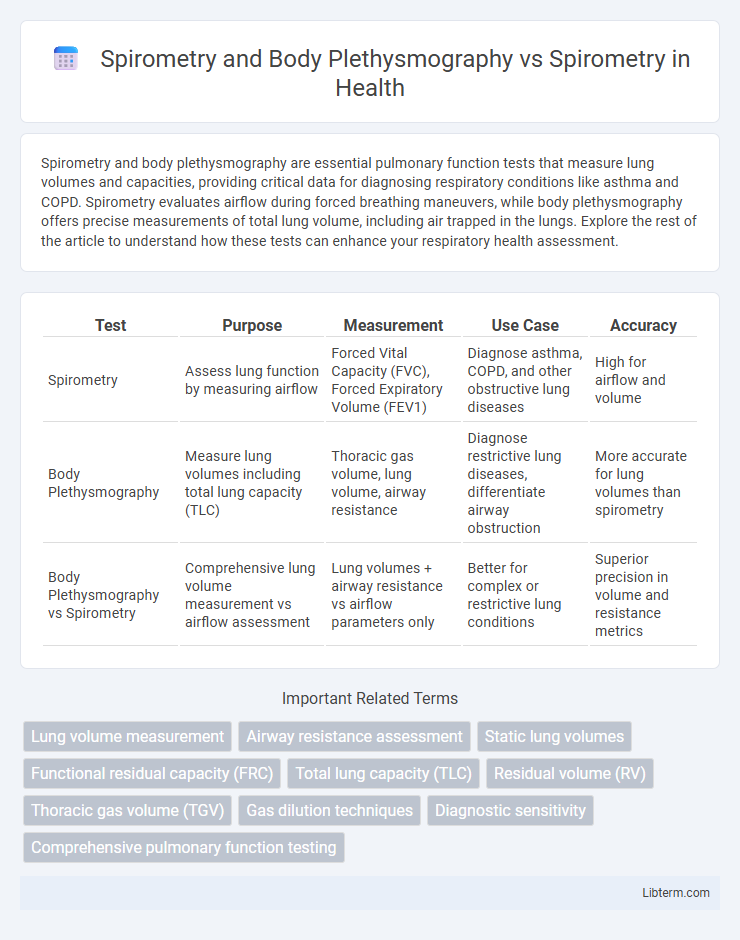Spirometry and body plethysmography are essential pulmonary function tests that measure lung volumes and capacities, providing critical data for diagnosing respiratory conditions like asthma and COPD. Spirometry evaluates airflow during forced breathing maneuvers, while body plethysmography offers precise measurements of total lung volume, including air trapped in the lungs. Explore the rest of the article to understand how these tests can enhance your respiratory health assessment.
Table of Comparison
| Test | Purpose | Measurement | Use Case | Accuracy |
|---|---|---|---|---|
| Spirometry | Assess lung function by measuring airflow | Forced Vital Capacity (FVC), Forced Expiratory Volume (FEV1) | Diagnose asthma, COPD, and other obstructive lung diseases | High for airflow and volume |
| Body Plethysmography | Measure lung volumes including total lung capacity (TLC) | Thoracic gas volume, lung volume, airway resistance | Diagnose restrictive lung diseases, differentiate airway obstruction | More accurate for lung volumes than spirometry |
| Body Plethysmography vs Spirometry | Comprehensive lung volume measurement vs airflow assessment | Lung volumes + airway resistance vs airflow parameters only | Better for complex or restrictive lung conditions | Superior precision in volume and resistance metrics |
Introduction to Pulmonary Function Testing
Pulmonary function testing evaluates lung function and helps diagnose respiratory conditions. Spirometry measures airflow and volume during forced breathing, providing key data on obstructive and restrictive lung diseases. Body plethysmography complements spirometry by assessing lung volumes and airway resistance, offering a more comprehensive analysis of pulmonary mechanics.
Understanding Spirometry: Principles and Applications
Spirometry measures lung function by assessing the volume and flow of air inhaled and exhaled, providing critical data on obstructive and restrictive lung diseases. Body plethysmography complements spirometry by measuring lung volumes, including those not expelled during forced breathing, offering a comprehensive assessment of total lung capacity and airway resistance. Understanding spirometry's principles and applications enables accurate diagnosis, monitoring of respiratory conditions, and evaluation of treatment efficacy.
Limitations of Spirometry in Lung Function Assessment
Spirometry often underestimates lung volumes as it cannot measure residual volume or total lung capacity, limiting its ability to fully assess obstructive and restrictive lung diseases. Body plethysmography provides more accurate measurements of lung volumes, including residual volume and airway resistance, offering a comprehensive evaluation of pulmonary function. These limitations in spirometry highlight the importance of body plethysmography for precise diagnosis and management in complex respiratory conditions.
Overview of Body Plethysmography
Body plethysmography offers a comprehensive evaluation of lung volumes by measuring thoracic gas volume through pressure changes in a sealed chamber, unlike spirometry which primarily assesses airflow and lung capacity. This technique provides precise measurement of residual volume and total lung capacity, critical for diagnosing restrictive and obstructive lung diseases. Enhanced accuracy in detecting airway resistance and lung compliance makes body plethysmography a valuable tool for detailed respiratory function analysis.
Key Differences: Spirometry vs. Body Plethysmography
Spirometry measures airflow and volume during forced breathing maneuvers, primarily assessing obstructive lung diseases such as asthma and COPD. Body plethysmography provides comprehensive lung volume measurements, including residual volume and total lung capacity, which spirometry cannot capture accurately. This makes body plethysmography more effective for diagnosing restrictive lung diseases and evaluating airway resistance.
Clinical Indications for Spirometry and Body Plethysmography
Spirometry is primarily indicated for diagnosing and monitoring obstructive airway diseases such as asthma and chronic obstructive pulmonary disease (COPD) by measuring parameters like FEV1 and FVC. Body plethysmography provides comprehensive assessment of lung volumes, including total lung capacity (TLC) and residual volume (RV), essential for identifying restrictive lung diseases and differentiating between pulmonary and extrapulmonary causes of restriction. Spirometry is typically used for initial screening and routine monitoring, while body plethysmography serves as a confirmatory test in complex cases requiring precise lung volume measurement.
Diagnostic Accuracy: When to Use Each Test
Spirometry is a fundamental pulmonary function test measuring airflow and lung volumes, primarily diagnosing obstructive airway diseases like asthma and COPD with moderate sensitivity. Body plethysmography offers enhanced diagnostic accuracy by measuring lung volumes and airway resistance, essential for detecting restrictive lung diseases and differentiating complex respiratory conditions. Use spirometry for initial screening and monitoring of airflow obstruction, while body plethysmography is indicated when spirometry results are inconclusive or when detailed lung volume assessment is required.
Spirometry and Body Plethysmography in Obstructive and Restrictive Lung Disease
Spirometry and Body Plethysmography provide complementary assessments in obstructive and restrictive lung diseases by measuring different lung volumes and airway resistance with high precision. Body Plethysmography is especially valuable in quantifying total lung capacity and residual volume, which aids in distinguishing between restrictive and obstructive pathologies when spirometry alone shows inconclusive results. Utilizing both methods enhances diagnostic accuracy, enabling more effective management of diseases such as chronic obstructive pulmonary disease (COPD) and interstitial lung disease.
Advantages and Disadvantages of Each Method
Spirometry provides valuable data on lung volumes and flow rates, making it a straightforward, cost-effective method for assessing airway obstruction but has limitations in accurately measuring lung volumes like total lung capacity. Body plethysmography offers precise measurements of lung volumes and airway resistance, including those unattainable by spirometry, enhancing diagnosis of complex lung conditions but requires more expensive equipment and specialized training. While spirometry is widely accessible and quick, body plethysmography delivers comprehensive pulmonary function insights essential for detailed evaluation despite higher costs and complexity.
Choosing the Right Pulmonary Function Test for Patient Management
Spirometry measures airflow and volume during forced breathing maneuvers, providing essential data for diagnosing obstructive airway diseases like asthma and COPD. Body plethysmography complements spirometry by accurately measuring lung volumes and airway resistance, crucial for detecting restrictive lung diseases. Selecting the appropriate pulmonary function test depends on the suspected pathology, with spirometry suited for airflow obstruction assessment and body plethysmography necessary for comprehensive evaluation of lung mechanics and volume measurements.
Spirometry and Body Plethysmography Infographic

 libterm.com
libterm.com